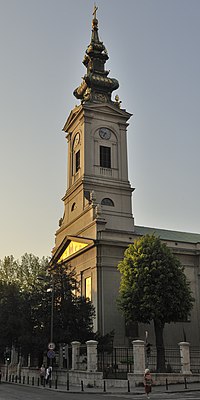St. Michael's Cathedral (Belgrade)
| Cathedral Church of St. Michael the Archangel | |
|---|---|
| Саборна Црква Св. Архангела Михаила | |

Saborna Crkva
|
|
| 44°49′05″N 20°27′08″E / 44.81806°N 20.45216°ECoordinates: 44°49′05″N 20°27′08″E / 44.81806°N 20.45216°E | |
| Location | Belgrade |
| Country |
|
| Denomination | Eastern Orthodoxy |
| Website | Saborna Crkva Official website |
| History | |
| Founded | 1837 |
| Founder(s) | House of Obrenović |
| Dedication | St. Michael the Archangel |
| Relics held |
King Uroš III Despot Stefan Štiljanović Prince Miloš I Prince Mihailo Prince Milan |
| Architecture | |
| Status | Church |
| Functional status | Active |
| Heritage designation | Monument of Culture of Exceptional Importance |
| Designated | 1979 |
| Architect(s) | Adam Friedrich Kwerfeld |
| Style | Neoclassicism with late baroque elements |
| Completed | 1840 |
| Specifications | |
| Number of domes | 1 |
The Cathedral Church of St. Michael the Archangel (Serbian: Саборна Црква Св. Архангела Михаила, Saborna Crkva Sv. Arhangela Mihaila) is a Serbian Orthodox Christian church in the centre of Belgrade, Serbia, situated in the old part of the city, at intersection of Kralja Petra and Kneza Sime Markovica Streets. There was an older church, dedicated to St. Arch. It is one of the most important places of worship in the country. It is commonly known as just Saborna crkva (The Cathedral) among the city residents. The Cathedral has been proclaimed as the 1st category cultural property in 1979.
The Cathedral Church in Belgrade with its architecture, art work and rich treasury is an impressive cultural monument. It is an invaluable historical monument of the Serbian sector of Belgrade from in first half of the 19th Century, which formed in area around the Cathedral Church, thus becoming its religious, administrative and cultural centre. During the times when new social and political structures were slowly emerging, the Cathedral Church became a central support in the independence fight from Turkish centralism to the final freedom from Ottoman rule.
There was an older church, dedicated to St. Archangel Michael, at the site of today’s church. Protestant priest and a writer on travel Stjepan Gerlach gives us precious records of its looks in descriptions of travels of Emperor’s delegates to Istanbul, 1573-1578. Although spacious with all necessary liturgical accessories and furniture it was not large enough to receive all the Christian citizens of town of Belgrade.
Later records of existence of this church were mainly saved by writers on travel from the 17th and the 18th century, who inform us broadly about its destiny. During Turkish-Austrian conflicts in the beginning of the 18th century it was destroyed, and the Austrian authorities were explicit in their order not to restore the damaged Serbian temples, former Metropolitan Mojsije Petrovic, who had expected the support of Russian Czar Peter The Great, who had meanwhile died, started renewal of the Church from its foundations, decorating it with a new iconostasis. Unfortunately, serious historical circumstances once again affected the life of the Church resulting in this being not the only restoration.
...
Wikipedia

